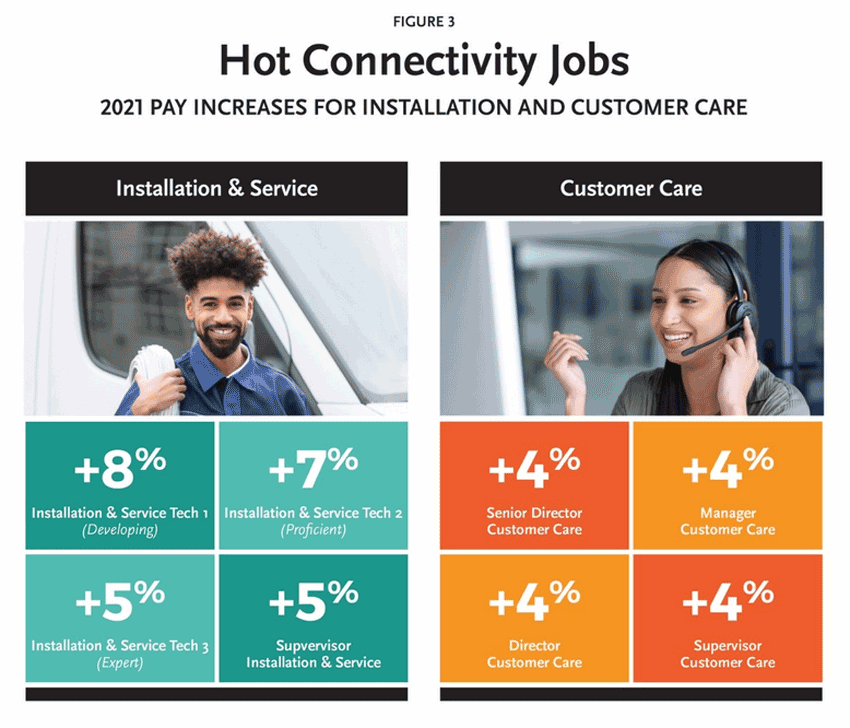

C2HR Surveys Reveal Pandemic's Uneven Impact on Pay
Compensation for connectivity providers climbed significantly during 2021, while pay at content developers rose modestly. This dichotomy, revealed in the 2021 Content & Connectivity Human Resources (C2HR) Compensation Surveys, reflects broader trends in the United States. While everyone suffered the physical, mental and social harms of the COVID-19 pandemic, economic consequences differed widely, depending on how lockdowns, physical distancing and remote work impacted survey participants’ core business.
Despite these challenges, both content developers and connectivity companies rewarded critical talent with pay raises. The surveys revealed that frontline installers, technicians, and customer care employees garnered healthy increases. Streaming experts, especially individuals skilled in programming and production, also benefitted from big pay gains.
“C2HR’s 2021 Compensation Surveys highlight our industry’s flexibility regarding compensation,” said Parthavi Das, C2HR’s Executive Director. “In spite of unforeseen disruptions to business-as-usual and intense economic pressures for some, our members targeted larger pay raises to workers who drove revenues and supported customers during these extraordinary times.”
Salary Budgets Uneven in 2021: Increases Expected in 2022
Content developer compensation slowed last year. The 2021, post-COVID salary adjustment budget for the 41 content participants dropped to 2.6%. Prior to that, budgets for raises were trending about 3%, on par with the national average.
“Content developers were challenged, particularly those who relied on ad sales and events,” said Hali Croner, President and CEO of The Croner Company, the research and compensation consulting firm that conducted the surveys for C2HR.
“Some companies had to furlough employees, reduce staff or implement pay cuts,” Croner continued. “If this hadn’t happened, we were seeing tremendous compensation growth that likely would have continued.”
The opposite occurred among the 13 connectivity providers that participated in the C2HR Compensation Surveys. These companies represent roughly 127,829 employees. The 2021 salary budget grew to 3%, up from 2.9% in 2020 and 2019.
The big news, revealed by the survey participants, is that salary budgets in 2022 are expected to rebound, increasing by at least 10%. Respondents reported projected 2022 salary budgets of 3.3% (connectivity) and 2.9% (content developers). The Croner Company expects these numbers could increase even more.
“Many in the industry think we may need slightly higher budgets to keep up with inflation and competitive pressures,” Croner said, adding that salary budgets of 3.5% (connectivity) and 3.3% (content) would not be surprising.
Connectivity Earns Big Pay Gains
Last year, connectivity personnel at all levels accrued substantial increases in total direct compensation (TDC). Executive TDC rose a whopping 16.5% (compared to 11.6% in 2020 and 8% in 2019). Middle management TDC climbed 5.7%; salaried employees 4.2%; hourly personnel 5.9%; and sales 6.3%. (See Figure 1) TDC includes base salary, bonus and stock incentives. These gains were driven by increased demand for robust broadband connectivity as the nation pivoted to telework, remote learning and increased use of streaming services.

In contrast, content developer executives saw TDC rise a modest 2% (compared to 3.3% in 2020 and 6.9% in 2019). Middle management TDC grew 2.1%; professional individual contributor (IC) 3.3%; and operating IC/support 4.4%. (See Figure 2)

Bonuses Reflect Pandemic Challenges
The bonus data collected in the 2021 C2HR Compensation Surveys also illustrate the different ways the pandemic impacted content developers versus connectivity companies. More content developers awarded bonuses below target, reflecting a challenging year. Content developers’ average bonus compared to target was 97%, with 42% below target. In contrast, connectivity providers’ average bonus compared to target was 115%, with 54% of bonus recipients achieving awards greater than 115% of target, and only 8% of bonuses below target.
Industry-Specific Benchmarks Deliver Targeted Data
C2HR’s Annual Compensation Surveys differentiate themselves from other national pay analyses by providing industry-specific benchmarks for job titles that are carefully curated by participants. The surveys provide data on 574 connectivity jobs and 722 content positions.
“The likelihood of finding our jobs in C2HR’s Compensation Surveys is very high because all media players consistently participate and engage with the survey team,” said Sharon Bulanhagui, Head of Total Rewards, People Analytics and HR Operations at Univision Communications. “We find it tremendously helpful to join the survey planning roundtables to influence the jobs that are represented each year. This collective input ensures that the surveys keep pace with changes in our industry.”
Nick Dunlap, Vice President of Executive Compensation at Charter Communications, added: “In addition, C2HR’s surveys help us to identify and address the emergence of ‘hot jobs’ within the industry as skills continue to converge,” Dunlap said. “The more targeted data points available to us, the more we can make informed, strategic compensation decisions.”
Frontline Workers Reap Pay Rewards
In 2021, the hot jobs at connectivity providers included employees interfacing with customers. Such direct contact was made more challenging due to the ongoing pandemic. Connectivity participants continued a multiyear trend of raising wages for frontline technicians and customer service reps. The 13 survey participants, which included multiple system operators, satellite providers and home security companies, reported pay gains ranging from 5% for supervisor of installation/service to 8% for entry-level installation/service technician. Customer care workers, another essential frontline cadre, accrued 4% raises across the board. (See Figure 3)

“Our company has taken a strategic approach to compensating these positions, with a commitment to provide a higher minimum hourly wage as an investment in the frontline employees who are critical to the success of our business,” explained Dunlap.
Programming and Production Net Big Gains
Content developers also rewarded mission-critical talent. Positions in programming and production captured very healthy pay boosts ranging from 2.6 to over 5 times the 2021 salary adjustment budgets (See Figure 4). For programming jobs, salaries climbed from 9% for manager, current programming, to as high as 12% for director, program development. Technical production positions also accrued substantial gains, ranging from 6% for graphics editors to 11% for supervisor, technical operations. Those trends continued in post-production and technical production. Editors and editing assistants earned 6% raises while senior producers achieved 14% escalations.

“While the industry needed to be conservative with compensation due to outside pressures, they also addressed the intense competition for talent,” noted Croner. “Although compensation slowed at a macro level, when you lift the hood, you see that content developers were actively competing for hot jobs by targeting those positions with larger increases.”
The pandemic also helped drive pay raises. “Our production and programming teams were one of the few teams that continued to work onsite in spite of the pandemic,” noted Bulanhagui. Production and programming employees struggled with fewer team members due to the pandemic, increased workplace safety measures and higher risk of COVID-19 exposure.
“They also were asked to reimagine their work/production to accommodate virtual audiences and virtual engagement, higher demand for streaming content and more digital solutions overall,” Bulanhagui added. Prolonged work under those conditions and higher demand for time spurred compensation increases.
C2HR’s Annual Compensation Surveys are vital to helping participants offer competitive salaries; anticipate trends in pay, bonus and equity awards; and respond with transparency to employees.
“We have a very aggressive growth agenda, and our talented teams are critical to ensuring we reach those objectives,” said Univision’s Bulanhagui. “We would be remiss if we didn’t lean heavily on competitive data to prevent our teams from participating in the ‘great resignation.’ It could derail our progress and demotivate our teams.”
C2HR’s targeted benchmarks also help participants retain employees. “We find that when armed with good data and transparent communications, our employees feel heard and valued for their work. We often use the C2HR Compensation Survey data to renew employment contracts, budget pay increases for employees below market and consider counteroffers,” continued Bulanhagui.
Such curated compensation data will be even more important in 2022. “We anticipate that the market for talent will continue to be highly competitive, particularly for technical roles,” said Dunlap.
“The resignation tsunami, a robust job market and need for digital talent has energized workers to ask and seek higher pay,” added Bulanhagui. “We will be challenged to either give in to the demand for pay or lose talent.”
C2HR’s 2021 Compensation Surveys included 54 participants. Companies included 13 connectivity providers and 41 content developers (see the attached 2021 participant list). The survey results are industry-specific, providing an in-depth analysis of pay practices for roughly 127,829 connectivity employees and 28,813 content workers, including both exempt and nonexempt positions ranging from technicians to top executives. The participants submitted data reflecting 2021 budgets, base compensation figures, bonuses and incentives.
Enroll to Participate in the 2022 C2HR Compensation Surveys
Content developers and connectivity companies can enroll to participate in the 2022 surveys by contacting Laurie Krashanoff at laurie@croner.biz. Please note that we strongly enforce confidentiality throughout the entire survey cycle from the planning meeting through published reports of results. To ensure confidentiality, the survey results from any given company cannot be seen, and only summary information pertaining to all survey participants is available. This reporting approach complies with Federal Trade Commission (FTC) regulation and encourages participation without fear of exposing proprietary information. For more information on the surveys, please visit Compensation Survey - C2HR.
|
|
|